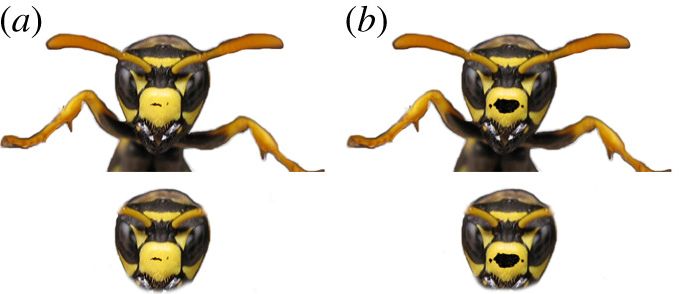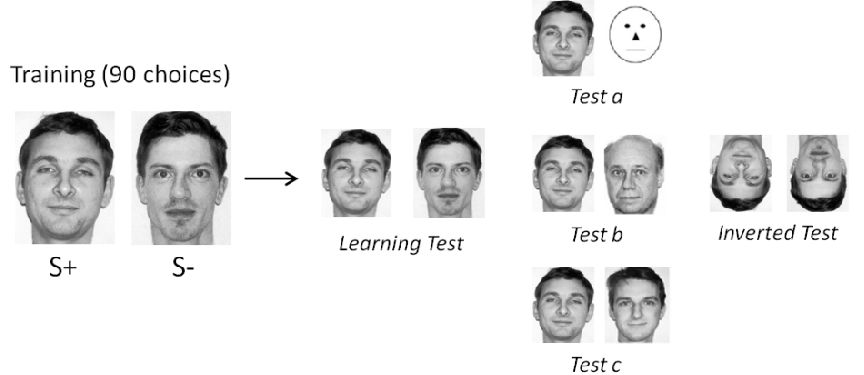Dark paper wasp – expert at face recognition
Have you ever realised how good we are at recognising each other’s faces?
We are able to do so since birth and, with normal every-day experience, we get even better at it. Our faces differ in many respects: the shape of the nose or mouth, eye colour, eye distance, and many other features. But we don’t view them separately. Our brains process human faces holistically – as a whole that is more than just the sum of its parts. For example, we can easily tell different noses apart when they are added to a picture of a face, but have much more difficulty when looking at the noses alone.
We are not the only species that process faces in a holistic manner.
As usual, we share our ability with our close relatives, the primates. But some wasps also show amazing skills in face recognition, as shown by the following experiments.
The dark paper wasps (Polistes fuscatus) were trained in a T-maze – a simple maze with only two side corridors, each marked with a different image. One of the corridors was safe*, which was indicated by a specific picture. The wasps learned fastest and made fewer mistakes if they had to choose between photos of faces of wasps from the same species. Learning was poorer if the faces didn’t have antennae, or were rearranged (the same antennae, eyes and other face parts but in different locations) or belonged to different species. Learning was also slower and less effective for pictures that for humans are clearly different – simple geometrical shapes or photos of caterpillars (the standard prey of these wasps).
In a different experiment the wasps were also trained to distinguish between wasp faces, but in this case the faces were either with antennae, body and legs, or in isolation, with none of those elements.

Similar to humans that have trouble distinguishing isolated noses, wasps had trouble with telling appart two faces without their natural context (antennae, legs and a body).
All these results show that these wasps are really good at recognising each other’s faces and, like humans, process faces in a holistic way.
But not all wasp species have special face-recognition skills
In the above experiments researchers tested also two other, closely related paper wasp species, the metric paper wasp (Polistes metricus; first experiment) and the European paper wasp (Polistes dominula; second experiment). The metric paper wasps did not learn to distinguish between individual faces of their own species, but did learn to distinguish between geometric patterns and photos of caterpillars and even faces of the dark paper wasp.
In the second experiment, European wasps could distinguish between faces, but the presence or absence of the rest of the body had no effect on learning, showing that they don’t process faces holistically.
Why do some wasps specialise in individual face recognition and others not?
This ability seems to be related to the importance of recognising individual animals in the wild.
In dark paper wasps, multiple queens start a nest together but do not have the same status. They fight to establish a dominance hierarchy early in the colony’s lifespan, leading to one individual laying most eggs and the rest having different roles. Being able to recognise each other reduces the number of fights, as wasps can remember the outcome of their previous fight with a specific individual or even learn their relative position in the hierarchy based on the results of the fights between others. These wasps also have variable facial markings, helpful in individual recognition.
Matric paper wasps establish nests individually and it is unlikely that recognising other individuals could be important to them. Their faces also don’t differ much between individuals.
European paper wasp females sometimes nest together and their faces differ by special markings related to fighting ability (stronger females have more spots) that they can recognise, but they don’t seem to pay much attention to individual differences.
Wasps can also recognise individual human faces.
This time researchers studied a different species: the common wasp (also known as common yellow-jacket, Vespula vulgaris). Individual wasps could fly freely and drink from feeders. Some feeders had sugar water in them and a photo of one man’s face next to it and others contained bitter water next to a face of another man. Over time wasps become very efficient at picking the correct feeders.
Afterwards they were tested with photos of the man associated with sugar water paired with an emoticon or photos of more or less similar men. The wasps could find the correct photo most of the time. Their performance was worse, but still better than chance, if the faces were upside-down.

Interestingly, another, similar experiment with digitally altered human faces indicated that wasps may be able to process human faces holistically.
Wasps have very good visual skills and learning abilities, so why not do some experiments with them when they appear in your garden (instead of fighting them)? Wasps are only dangerous if you are allergic to their venom and they will attack usually only if you get too close to their nest or press their bodies.
* The floor of the maze was mildly electrified, except for one “safe” arm.
Polska wersję tego postu możesz znaleźć tutaj.
Photo of the dark paper wasp: Judy Gallagher – https://www.flickr.com/photos/52450054@N04/30947768803/, CC BY 2.0, https://commons.wikimedia.org/w/index.php?curid=54773019

